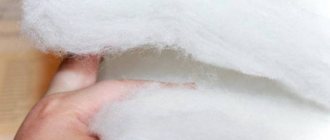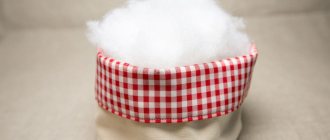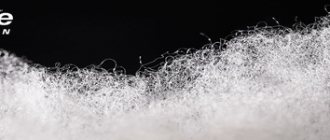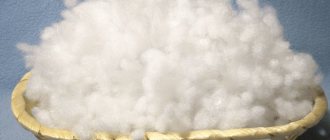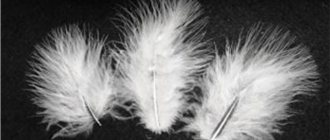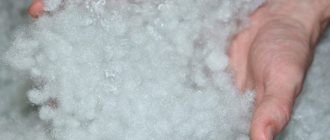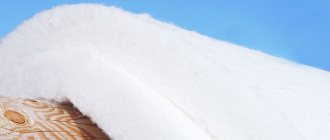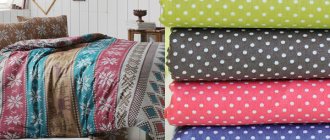Holofiber is one of many modern universal materials. Developed by Russian scientists, a type of synthetic non-woven elements with a trademark. The fabric consists of spiral types of fiber. Forms a large number of pores. They are air cavities. They are a product of petroleum refining. The material is not very expensive.
Placed inside the canvas randomly and vertically. Products with pores distributed uniformly over the entire surface. With a density of 60 g/m2 and up to 4000. Made from chemical compounds of polyester, with thermal fixing.
During production, raw materials for manufacturing are passed through wind tunnels. The result is a canvas, without layers. The manufacturing process takes place at high temperatures. In its presence, the fibers are soldered together. The connection is reliable, durable and elastic. With its characteristic properties.
The components are connected in structure, have no weak points, and are difficult to break. The material is environmentally friendly and contains a minimum amount of harmful compounds. Does not emit toxicity and does not cause irritation to human skin. A stable element, does not decompose in the environment, does not rot.
It is warm, with low thermal conductivity, and retains heat well. It has elasticity and can be given any configuration. It never bunches up in different places and does not form pellets. Absorbs noise waves. Withstands a large number of washes and the use of hot water. Doesn't increase the heat in a fire, just melts. Dries quickly after contact with water. You can easily remove dirt stains from it. Tolerates thermal effects. This is 100% high grade synthetic! Buyers admire holofiber!
There are many varieties for use. Modern fillings for objects and various insulation materials are made from it. Holofiber is an alternative to down, padding polyester, and wool . Used in construction as thermal insulation or sound insulation. In the aviation industry, in space development. Used for making filters. Serves as a filler. Actively used:
in sewing clothing for children and adults;
- for shoes;
- filling furniture structures;
- bedding accessories;
- soft toys;
as insulation for apiaries.
The scope of its use is quite wide, it becomes an indispensable material. The heat, when using holofiber, remains inside the product. This occurs due to the structure of the fibers. The spiral spring of the material forms an "air chamber". This helps retain heat.
Advantages. The advantages cannot be listed. It is characterized by the following properties:
- the filler does not absorb odors;
- does not ignite;
- does not crumble;
- does not deform from washing;
- Microorganisms and moths do not settle in it.
Holofiber, if desired, takes on any shape. After compression of the material, its shape is restored.
Types of filling for winter jackets
All down jacket fillers can be divided into two groups:
- natural;
- synthetic.
The first type naturally includes goose down and feathers. The second group includes synthetic winterizer. These have long been known insulation materials. But science and progress do not stand still, and now there are many modern insulation materials on the market.
Thinsulate filler: what is it, pros and cons, what temperature is it designed for?
Thinsulate can rightfully be considered a new generation of insulation. The name is not simple, but in other words it is artificial swan's down. This insulation is a siliconized polyester fiber twisted into a spiral. This fiber is 60 times thinner than human hair, its diameter is 5 microns. The fiber spirals are covered with silicone around which there is air, it is this air that retains heat and warms. Thinsulate was invented back in the 60s of the last century by order of NASA. it was intended to insulate the spacesuits of astronauts and polar explorers. Now this material is used in sewing equipment for skiers. In terms of thermal characteristics, Thinsulate is 1.5 times higher than natural swan down.
Like all materials, it has its advantages:
- holds heat well;
- light and soft;
- does not fall off when worn;
- not allergic;
- environmentally friendly material;
- does not absorb odors; lasting;
- does not deform after washing and does not shrink;
- dries quickly.
There are also disadvantages and they are worth talking about:
- accumulates static electricity;
- may cause overheating.
Considering all of the above, jackets with thinsulate are suitable for regions with harsh winters and those who enjoy skiing or snowboarding. It is in such conditions that it will warm the body and provide comfort.
About polyester
A common polyester is a polymer made from polyester fibers.
Polyester resembles wool in appearance, but its properties are very similar to cotton. Their polyesters create many useful things, from tableware to workwear. It tolerates light and atmospheric influences well. Polyester fabrics are in no way inferior to natural materials. But, in some ways, they may differ from them. And so, there are no differences either in quality or beauty. The characteristics of the material depend on the shape of the fibers used and their processing. Has characteristics:
- high strength;
- immunity to organic solvents;
- abrasion resistance;
- does not burn, but melts;
- does not affect a person as an allergy sufferer;
- has no toxicity.
Polyester is so popular that it accounts for 60% of the textile market.
Some people assume that since it is a synthetic element, it is uncomfortable to wear. They assume, in general, that this is a harmful element! But that's not true! Polyester is produced using innovative mechanisms. Made from quality raw materials. This is a completely safe element for people and animals. A very practical element, quite beautiful, differing from other synthetics in its high cost! Its characteristics depend on the shape of the fibers used and their pre-treatment. Objects accumulate static electricity. For this reason, dust particles may stick to clothing items. Because of this, the fabric can be attracted to the skin. But these negatives can be easily eliminated. When working with it, you must use conditioner. To eliminate static electricity, manufacturers add antistatic fibers to the components. Then the operation of the items is carried out without interference.
Lining and upholstery are elements made from this synthetic material. They serve without changing shape and cannot be stretched. They cannot let water pass through them and do not wrinkle at all. Retains its original appearance for a long time. Linings are irreplaceable elements used in clothing production. Different dresses, trousers, suits. Linings for clothes worn in cold weather are given the properties of protection from winds and rain.
Holofiber filler, what is it, pros and cons, what temperature is it designed for?
What is it. The answer is simple, like everything ingenious. The translation of this word from English means “hollow fibers.” Hollofiber is made of synthetic fiber that is hollow inside and twisted. It is this structure that allows for good heat retention.
The positive qualities of this material include:
- ease;
- high thermal conductivity;
- affordable price; does not electrolyze;
- does not absorb foreign odors;
- hypoallergenic.
Holofiber has no negative qualities. It is worth noting that the thermal properties are slightly inferior to goose down and feathers. As for the temperature regime, first of all we need to talk about the density of the insulation (the higher the density, the stronger the frost it can withstand). For winter, it is best to choose jackets with a holofiber density of 200 g/sq.m, temperature -10 -20 degrees, and 300 g/sq.m, temperature -20 -30 degrees.
Made from polyamide (nylon)
Polyamide (nylon)
often used in outerwear materials. Fabrics with its addition are more expensive than polyester, since it is the most expensive synthetic fiber. Its properties are very similar to polyester, but it has greater strength and durability. Fabrics made from polyamide (nylon) are resistant to moisture, but this property is slightly less pronounced than that of polyester fabric. Materials for outerwear can be made from 100% polyamide or combined, including with polyester. Interestingly, just a small percentage of this material increases the strength and wear resistance of the fabric several times. Various fiber cross-section shapes allow you to create a variety of textures: shiny and matte. Polyamide fabrics, thanks to very good dyeing, can come in a variety of colors.
| A raincoat made of fabric containing linen and polyamide, the strongest textile fibers, is not subject to “demolition”, and only 20% polyamide and the raincoat does not absorb water and dirt and becomes very durable. | Polyamide mixed with polyester “creates” a fabric very similar to silk. | A lightweight down jacket made of bright 100% nylon fabric perfectly repels dirt and water. |
In its pure form, 100% nylon is a soft, dense and very light fabric. A windbreaker made of this material will easily fit into a small handbag when folded and will not weigh it down at all. Jackets, raincoats, down jackets made from nylon fabric or with the addition of nylon are very wearable and durable, hold their shape well, do not wrinkle, are easy to wash, do not require ironing, and dry quickly. Such things will not get wet and will perfectly protect from the wind.
Sustans filler what is it, pros and cons what temperature is it designed for
Sustans insulation is a type of bio-down. It is produced using a biopolymer, which is patented by DuPont Sorona. It was this filler that received approval for the “bio-based product” label in America. The spherical shape of the fibers makes the filler fluffy and silky to the touch. It retains heat well and is ideal for winter clothing. A jacket with sustans will keep you warm even at 40 degrees.
Isosoft filler, what is it, pros and cons, what temperature is it designed for?
Isosoft is an innovative material that was invented by Libeltex specialists, who initially made highly sensitive filters. The insulation is made from hollow fibers of a polyester polymer called fine-denie.
Isosoft has a number of positive qualities:
- hypoallergenic;
- great thermal insulation;
- excellent breathability;
- dries quickly;
- Machine washable.
The insulation is weightless, which is good for winter jackets. It will be easy and comfortable to walk in it. Thanks to the properties of the material, the jackets are very warm. Clothing with isosoft is very warm and can withstand frost down to -35 degrees. Strong wind is also not a problem, because... the material is not blown through. This insulation is often used for sewing winter clothes for children. Isosoft is not cheap, but its qualities will pleasantly surprise the owner and warm him up in the winter cold.
Application for sewing workwear and other areas
Hollophan is ideal for the production of workwear . In this form, the worker is not constrained in his movements and is protected from the cold even in frosty weather. After cleaning or washing, the product dries in a matter of hours, which saves time and money.
Holofan is used to equip rescuers, State Traffic Inspectorate employees, as well as workers in other specialties related to activities in the cold season.
Hollophan, like other synthetic insulation materials, has found wide application in the domestic sphere . It is used wherever thermal resistance and rapid recovery of shape after load are needed.
In addition to its intended purpose, the material fits perfectly into the process of sewing bedding, as well as stuffing soft toys and furniture.
Sometimes synthetic material finds unexpected uses. Some motorists install a subwoofer in the car and use holophane to fill it . This is done in order to improve the sound.
We will tell you in the next review what materials and fillers are used in the production of winter camouflage clothing.
Find out where thermofin insulation is used here.
Read about the performance properties of shelter insulation in this article.
Baby go filler what is it, pros and cons what temperature is it designed for
Baby Go is a Russian brand of clothing for children, aimed at the domestic market. Particular attention is paid to outerwear. After all, with the arrival of cold weather, parents want to buy a warm and practical thing. Clothes are made from high-quality material. The top of the jackets is predominantly made of polyester, the lining is a mixture of polyester and cotton. The filling is most often natural down and feathers.
Such outerwear will have the following advantages:
- not allergenic;
- environmentally friendly filler;
- warm;
- easy fabric care.
You will be comfortable in such a jacket even at -30 degrees. Wind and precipitation are also not a problem.
History of origin and manufacturing technology of filler
Polyester insulation is the name of a fiber created on the basis of polyethylene terephtharate. The material appeared in the first half of the 20th century. and was mainly used in chemical, automotive, food and other industries. Mass distribution began a few years later, in the 1960s, when it was discovered that fabric clothes do not wrinkle and practically do not get dirty. In addition, the cost of insulation for polyester clothing was much cheaper.
Material polyester
Important! The name differed in different countries: in the USSR it was lavsan (later synthetic winterizer), in the USA and Europe - polyester (or foamed polyester), Dacron, Melinex, etc.
The starting material for insulation is fiber obtained from gas and oil products. Production consists of several stages:
- The raw materials are pre-prepared: cleaned and loosened.
- The purified raw materials are pressed through dies (special molds), after which fibers are obtained.
- The fibers are dyed and processed, then formed into a cloth.
- The canvas is undergoing final finishing.
Important! The properties of the finished material largely depend on the method of bonding the fibers in the fabric.
Insulation in clothes
Camel wool filler reviews, pros and cons, what temperature it is designed for
Camel wool has long been valued for its high thermal properties. It is very warm and light. If you compare the wool of merino sheep and camels, the wool of the latter is twice as light.
This filler has the following advantages:
- in terms of thermal conductivity properties, camel wool is superior to other types of wool;
- the effect of dry heat has a beneficial effect on the human body and can relieve symptoms of colds, neuritis, and osteochondrosis;
- wool fibers have micropores, which allows it to breathe, which means it retains heat better; does not electrolyze;
- does not get dirty when worn;
- repels dust.
A jacket with camel hair will be comfortable even at 20 or 30 degrees below zero. You need to take proper care of this down jacket. It is suitable for hand washing with a water temperature of no higher than 30 degrees. It is necessary to use a special wool detergent or shampoo with lanolin. You should squeeze it out carefully with your hands. After this, the jacket is placed on a horizontal surface, preferably on fabric. It is she who will absorb moisture. After the item has dried, it must be taken out to a cool, ventilated room for further drying. Proper care will allow you to extend the life of your down jacket and keep you warm in winter with health benefits.
Same characteristics
Polyester and synthetic winterizer are synthetic materials . The basis for them is polyester fibers. Since the composition of the materials is approximately the same, they have several similar characteristics:
- High hygroscopicity.
- Thermal conductivity.
- Long service life (if the composition meets quality standards).
- Protection against the development of bacteria and microbes (due to artificial components).
- Hypoallergenic.
The products are easy to care for and can withstand long-term wear without changing shape or color.
In the manufacture of down jackets and winter sets, both of these materials can be used: polyester as a fabric, synthetic padding as a filler and a warm lining.
To impart additional uncharacteristic properties, natural materials (cotton, wool, silk) can be added to the fabric and filling. These products have become the most popular among synthetics due to their many quality properties.
Bio fluff filler reviews, pros and cons, what temperature it is designed for
This type of insulation was developed in the 70s of the last century. It was supposed to serve as a filler for the clothing of polar explorers, and the properties of bio-down were calculated for the most severe weather conditions. This insulation is produced from a biological base. It is soft and fluffy to the touch. It has an airy structure and is similar to natural fluff. Bio fluff resists compression well and tends to immediately take its original shape.
The positive properties of the material include:
- retains heat well;
- the insulation retains the shape and volume of the jacket and does not come out through the seams;
- Jackets with bio down are easy to care for and can be machine washed;
- easy;
- does not absorb foreign odors and does not cause skin irritation;
- moisture resistant, which is especially important for winter;
- has high wear resistance.
Negative qualities include:
- capable of accumulating static electricity;
- Jackets with bio-down cannot be placed on heating devices, because the material is afraid of high temperatures;
- the price of such insulation may be higher than that of natural insulation.
In general, the insulation is good and can withstand frost of 40 degrees. It is also worth considering individual tolerance to low temperatures.
How to care for products with holophane?
Holophane products are easy to care for; They can be washed not only by hand, but also in the machine. In order for the thermal insulation properties to be preserved as long as possible, it is better to set a gentle washing mode: water temperature up to 40 ° C, spin speed - no more than 600. In the case of hand washing, it is enough to slightly twist the product by hand and hang it to dry on hangers away from heating devices and solar light. Hollofan dries quickly, even if it does not spin at all, as it repels moisture.
If a product with this insulation gets very dirty, you can take it to the dry cleaner or use a stain remover. This will not harm Holofan as it is resistant to chemicals. When using stain remover, follow the instructions carefully to avoid damaging the outer fabric. Before use, it is recommended to test the durability of the paint by dropping a small amount of the product onto an inconspicuous place.
Jackets and suits with holofan are best stored on hangers, but if this is not possible, they can be placed on a shelf in the closet. Blankets, pillows, soft toys can also be folded - they restore their shape. If it is holophane insulation, it can be rolled up and sealed with polyethylene.
Cotton filler reviews, pros and cons, what temperature it is designed for
Now in stores you can find down jackets filled with Spray bonded cotton wool or spray bonded wadding. This is an environmentally friendly insulation made from cotton and cotton wool.
The insulation has the following advantages:
- easy;
- wear-resistant;
- high thermal insulation;
- breathable material.
According to its characteristics, cotton is close to bio-down. In addition, the material is not subject to rotting, and microorganisms will not grow in it. The material does not cause allergies. In such a down jacket you will be comfortable even in the most severe frost (-30 degrees). Indeed, in Soviet times, the main outerwear for winter were quilted jackets.
The warmest filling for a winter jacket
After reading the information above, most may wonder which filler is better. After all, they are all good. Of course, natural down and feathers retain heat well, but such jackets are difficult to care for. And over time, the fluff can fall off, and some of it can come out of the fabric. Synthetic varieties are more unpretentious in care and are not inferior in their characteristics to jackets with natural fillers. First among them is Thinsulate. It was developed specifically for extremely low temperatures. It is easy to care for, and it does not absorb foreign odors. And this is a big advantage. If you want to buy a jacket with natural filling, then look for a model with eider down. It is light and very warm. It was eiderdown that was previously used for pilots’ clothing.
Reviews
In most cases, reviews of polyester insulation are positive, regardless of the specific material.
Sergey, 45 years old, Samara: “I bought a jacket with Thinsulate filling and was very surprised: if I go out at -20°C it’s hot, -25°C is hot, even at -30°C I can walk in a T-shirt. Then I read that Thinsulate is an insulation material for the harshest conditions; it doesn’t care about the Moscow frost. I’m extremely pleased with the jacket, although it’s a bit hot.”
Natalya, 32 years old, Vologda: “I was choosing a children’s overalls (an active 5-year-old boy) and settled on isosoft. Frequent washing does not deteriorate, does not clump, dries quickly - very convenient.”
Polyester filler - what is it? This is the general name for artificial insulation for outerwear. It is divided into several types: padding polyester, synthetic down, holofiber, isosoft, etc. These materials have similar characteristics, but differ in small details, which must be taken into account when choosing so as not to be disappointed in the purchase.
Which filling is best for a children's winter jacket and overalls?
The filling of children's clothing must be approached responsibly.
For your child, you can safely choose synthetic fillers:
- isosoft;
- holofiber.
They are environmentally friendly, heat well and are affordable. You should avoid padding polyester, because... This is a recycled product and may release harmful substances. You shouldn’t chase advertising and buy your child a jacket or overalls with Thinsulate. It is unlikely that you will go out and take a long walk in the bitter cold. Still, this filler is designed for athletes and polar explorers. And in price it will be more expensive than isosoft and holofiber.
Which filler is best for winter clothes for adults?
For adults, we recommend choosing jackets with isosoft and holofiber. They are more practical to wear and care for. If you buy a down jacket filled with down feathers, it is better to have it dry cleaned. Washing such a thing at home is problematic. If you love extreme sports or just skiing, then you should think about purchasing a jacket with Thinsulate. This material is designed for this. In general, rely on your feelings and individual tolerance to cold.
This article describes the types of fillers and their characteristics. Using this information, you can choose a warm and comfortable winter jacket for yourself. Good luck with your choice.
Rules of care
Polyester is not demanding and easy to care for:
- it can be washed at a temperature of 30-40 ° C;
- To prevent the insulation from clumping, you can wash tennis balls with a down jacket. They will prevent the filler from crumpling;
- When washing white items, you can use any universal detergent; for colored items, you can use detergents for colored or delicate fabrics to preserve the color;
- Dry away from direct sunlight. It is best to shake the clothes and hang them on hangers;
- Polyester usually does not require ironing, but if necessary, you can iron it on the delicate or “Silk” mode using a damp cloth;
- You can store things in any form.
Washing a down jacket with balls

